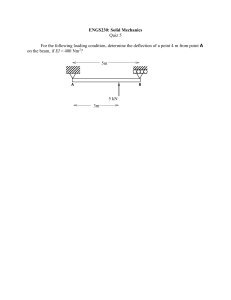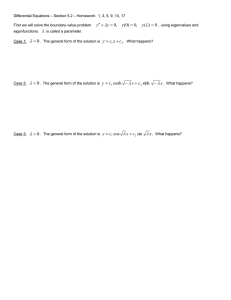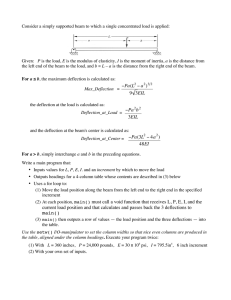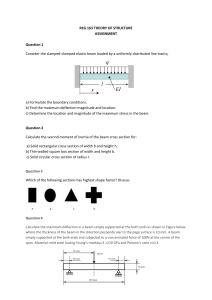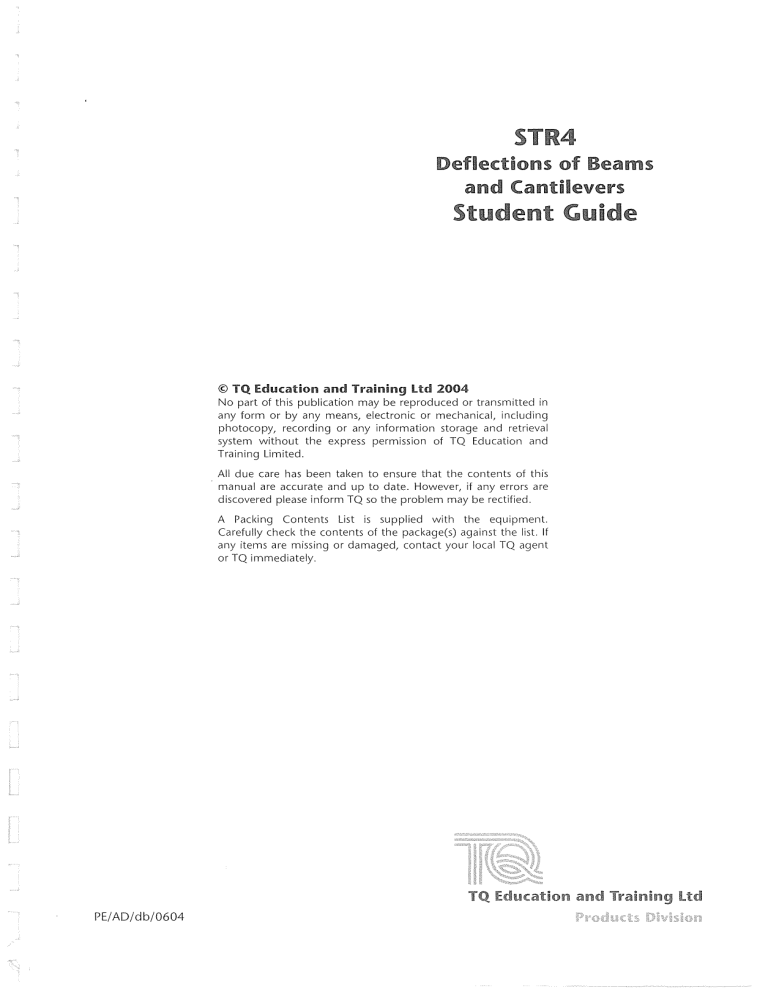
STR4
Deflections of Beams
and Cantilevers
Student Guide
© TQ Education and Training ltd 2004
No part of this publication may be reproduced or transmitted in
any form or by any means, electronic or mechanical, including
photocopy, recording or any information storage and retrieval
system without the express permission of TQ Education and
Training Limited.
All due care has been taken to ensure that the contents of this
· manual are accurate and up to date. However, if any errors are
discovered please inform TQ so the problem may be rectified.
A Packing Contents List is supplied with the equipment.
Carefully check the contents of the package(s) against the list. If
any items are missing or damaged, contact your local TQ agent
or TQ immediately.
TQ Education and Training Ltd
PE/AD/db/0604
SECTION 1 INTRODUCTION AND DESCRIPTION
Fixing holes
Scale
Moveable digital dial
test indicator
Clamp
Moveable
knife-edge
U-section
channel
Knife-edge
load hanger
Scale
Moveable
knife-edge
Clamp
Fixing holes
Figure 1 Deflection of Beams and Cantilevers experiment
Introduction
This guide describes how to set up and perform
experiments on the deflection behaviour of beams and
cantilevers. The equipment clearly demonstrates the
principles involved and gives practical support to your
studies.
Description
Figure
shows the Deflections of Beams and
Cantilevers experiment. It consists of a backboard with
a digital dial test indicator. The digital dial test indicator
is on a sliding bracket which allows it to traverse
accurately to any position along the test beam. Tv.:o
rigid clamps mount on the backboard and can hold the
beam in any position. Two knife-edge supports also
fasten anywhere along the beam. Scales printed on the
backboard allow quick and accurate positioning of the
digital dial test indicator, knife-edges and loads.
Look at the reference information on the backboard.
It is useful and you may need it to complete the
experiments in this guide.
How to Set up the Equipment
The Deflections of Beams and Cantilevers experiment
fits into a Test Frame. Figure 2 shows the Deflections of
Beams and Cantilevers experiment in the Frame.
Before setting up and using the equipment. always:
•
•
•
"
Visually inspect all parts. including electrical leads.
for damage or wear.
Check electrical connections are correct and secure.
Check all components are secure and fastenings are
sufficiently tight.
Position the Test Frame safely. Make sure it is on a
solid. level surface. is steady, and easily accessible.
Never apply excessive loads
equipment.
Page 1
to any part of the
TQ Deflections of Beams and Cantilevers: Student Guide
Specimen
beam
i
98mm
•
Digital dial test indicator
on sliding bracket
Securing
thumbscrews
~
@
@
•
\
I
Clamp
(2 off)
Hanger and
masses
Moveable
knife-edge
(2 off)
Clamp
mounting
holes
Figure 2 Deflections of Beams and Cantilevers experiment in the structures frame
The following instructions may already have been
completed for you.
them to roughly the positions or the thumbscrews
shown in Figure 2.
I. Place an assembled Test Frame (refer to the separate
instructions supplied with the Test Frame if
necessary) on a workbench. Make sure the
•window· of the Test Frame is easily accessible.
3. Lift the backboard into position and have an
assistant secure it by threading the thumbscrews into
the securing nuts. If necessary. level the backboard
by loosening the thumbscrews on one side.
repositioning the backboard, and tightening the
thumbscrews.
2. There are two securing nuts in each of the side
members of the frame (on the inner track). Slide
Page 2
SECTION 2: EXPERIMENTS
Experiment 1: Deflection of a Cantilever
Remove any clamps and knife edges from the
backboard. Set up one of the cantilevers as shown in
Figure 3.
Slide the digital dial test indicator to the position on
the beam shown in Figure 3, and lock it using the
thumbnut at the rear. Slide a knife-edge hanger to the
position shown.
Tap the frame lightly and zero the digital dial test
indicator using the ·origin• button .
Apply masses to the knife-edge hanger in the
increments shown in Table 1. Tap the frame lightly each
time you add the masses. Recore! the digital dial test
indicator reading for each increment of mass.
Repeat the procedure for the other two materials and
fill in a new table.
In this experiment, we will examine the deflection of a
cantilever subjected to an increasing point load. We will
repeat this for three different materials to see if their
deflection properties vary.
•
Material
I
Evalue:
Nm
m
I:
-2
4
Width b:
mm
Depth d:
mm
w
Mass
Actual deflection
Theoretical deflection
Figure 3 Cantilever set-up and schematic
(g)
(mm)
(mm)
You may fine! the following table useful in converting
the masses used in the experiments to loads.
100
0
200
300
Mass (Grams)
Load (Newtons)
100
0.98
200
1.96
300
2.94
400
3.92
500
4.90
400
500
Table 1 Results for Experiment 1 (beam 1)
Table 1 Grams to Newtons conversion table
Material
As well as the information given on the backboard you
will need the following formula:
Deflection
=
I
Evalue:
Nm
m
I:
WL'
Mass
3£1
(g)
_/
4
-2
Width b:
mm
Depth d:
mm
Actual deflection
Theoretical deflection
(mm)
(mm)
0
where:
W= Load (N)
100
L = Distance from support to position ol" loading
200
(m):
300
E = Young·s modulus for cantilever material (Nrn
400
J = Second moment of area of the cantilever ( m•l).
500
Using a vernier gauge. measure the width and depth or
the aluminium. brass and steel test beams. Record the
values next to the results tables for each material and
use them to calculate the second moment of area. /.
Table 2 Results for Experiment 1 (beam 2)
Page 3
TQ Deflections of Beams and Cantilevers: Student Guide
Material
Evalue:
I
Nm
m
I:
4
-2
Width b:
mm
Depth d:
mm
Mass
Actual deflection
Theoretical deflection
(g)
(mm)
(mm)
0
100
200
300
400
On the same axis, plot a graph of Deflection versus
Mass for all three beams. Comment on the relationship
between the mass and the beam deflection. Is there a
relationship between the gradient of the line for each
graph and the modulus of the material?
Calculate the theoretical deflection for each beam
and acid the results to your table and the graph. Does the
equation accurately predict the behaviour of the beam?
Why is it a good idea to tap the frame each time we
take a reading from the digital dial test inclicator'7
Name at least three practical applications of a
cantilever structure.
500
Table 3 Results for Experiment 1 (beam 3)
Page 4
TQ Deflections of Beams and Cantilevers: Student Guide
Experiment 2: Deflection of a Simply Supported Beam
Nm-2
In this experiment, we will examine the deflection of a
simply supported beam subjected to an increasing point
load. We will also vary the beam length by changing the
distance between the supports. This means we can find
out the relationship between the deflection and the
length of the beam.
As well as the information given on the backboard
you will need the following formula:
Maximum deflection
=
m
4
mm
Depth d:
mm
Mass
Actual deflection
Theoretical deflection
(g)
(mm)
(mm)
0
100
wd
200
300
48£/
400
where:
W = Load (N);
L = Distance from support to support (m);
500
Table 4 Results for Experiment 2 (fixed beam
length variable load)
= Young's modulus for cantilever material (Nm-\
J = Second moment of area of the cantilever (m\
E
Part 2
Part i
Using a vernier gauge. measure the width and depth of
the aluminium test beam. Record the values next to the
results table and use them to calculate the second
moment of area. /.
Remove any clamps from the backboard. Setting
length between supports I to 400 mm. set up the beam
as shown in Figure 4.
Set up the beam with the length I at 200 mm. Ensure the
digital dial test indicator and load hanger are still central
to the beam, as shown in Figure 5.
r/=200 mm•1
I
I
400 mm --
_ _j)
....
!◄·---·- 200 rnrn ----->-~---200
mm - --·►i
i
1
7 I
l
t-
I
w
I
t
LJ
Figure 5 Simply supported beam set-up and
schematic (fixed beam load with variable length)
w
Figure 4 Simply supported beam set-up and
schematic (fixed beam with variable load)
Slide the digital dial test indicator into position on the
beam and lock it using the thumbnut at the rear. Slide a
knife-edge hanger to the position shown.
Tap the frame lightly and zero the digital dial test
indicator using the ·origin· button.
Apply masses to the knife-edge hanger in the
increments shO\vn in the results table. Tap the frame
lightly each time. and record the digital dial test
indicator reading for each increment of mass.
Lightly tap the frame and zero the digital dial test
indicator using the ·origin' button. Apply a 500 g mass
and record the deflection in Table 5. Repeat the
procedure for each increment or beam length.
From Table 4 plot a graph of Derlection versus
Applied Mass for a simply supported beam. Comment
on the your graph. Inspect the ruling equation of the
beam. What is the relationship between the der!ection
and the beam length') Test your assumption by filling in
the empty column of Table 5 with the correct variable.
Plot a graph.
Page 5
TQ Deflections of Beams and Cantilevers: Student Guide
Length (mm)
Deflection (mm)
Name at least one example where this type of bending is
desirable and one where it is undesirable.
200
260
320
380
440
500
560
Table 5 Results for Experiment 2 (fixed beam load
variable length)
Page 6
TQ Deflections of Beams and Cantilevers: Student Guide
Experiment 3: The Shape of a Deflected Beam
This experiment shows how the deflection of a loaded
beam varies with span.
Traverse the loaded beam with the digital dial test
indicator recording the deflections.
Position from
Datum
Loaded
Deflection
left (mm)
reading (mm)
reading (mm)
(mm)
0
20
40
60
80
100
i - - - - - - 6 0 0 mm--------..i
1-x~
150
200
l◄-200
250
mm_j+-200 mm-+1
t
300
I
350
w
400
Figure 6 Simply supported beam set-up and
schematic
450
500
Remove any clamps from the backboard and set up the
beam as shown in Figure 6.
Slide the digital dial test indicator to the zero
position on the beam and. using the ·±· button. set it so
a downward movement reads negative. Do not lock the
digital dial test indicator. Slide a knife-edge hanger to
the correct position on the beam.
Tap the frame lightly. Roughly zero the digital dial
test indicator using the ·origin' button. Record the
actual ·datum· value in Table 6.
Carefully slide the digital dial test indicator to the
positions shown in Table 6 (note the change in the
increments after I 00 mm). Remember to tap the frame
each time you take a reading. Record the 'datum· value
at each position.
Apply a 500 g mass to the knife-edge hanger and
return the digital dial test indicator to the zero position.
Make sure the digital dial test indicator stylus passes
through the gap in the knife-edge hanger.
550
600
Table 6 Results for Experiment 3
Work out the true deflection from the datum and loaded
values. Why is it important to take datum values in this
experiment''
Plot a graph of deflection versus position along the
beam. What shape does the beam adopt outside the
bounds of the knife-edge supports'7 Why is that')
Using a suitable method calculate the true deflection
of the beam (within the bounds of the knife-edge
supports) and acid the data to the graph. Does the
method you have used accurately predict the shape of
the deflected beam' 1
Page 7
TO Deflections of Beams and Cantilevers: Student Guide
Experiment 4: Circular Bending
J,.
In this experiment, we apply loads to a simply
supported beam at its encl to induce a moment and thus
produce circular bending. As well helping to establish
an important relationship, this test is an accurate method
for measuring Young's modulus.
-- _________________ ih ______________ _
I -c--1~
R • Radiosof co~atoce (m);
' \
C = Chord (m);
R\ ' • Height of chocd (m).
Figure 8 Radius of curvature
Using a vernier, measure the width and depth of the
aluminium. brass and steel test beams. For each
material. record the values next to the results tables and
use them to calculate the second moment of area, /.
Remove any clamps from the backboard and set up
the beam as shown in Figure 7.
Slide the digital dial test indicator into position on
the beam and lock it using the thumbnut at the rear.
Slide a knife-edge hanger on to each encl of the beam as
shown.
Tap the frame lightly and zero the digital dial test
indicator using the ·origin' button.
Tapping the frame lightly each time, apply masses to
the knife-edge hangers in increments as shown in
Table 7. Record the digital dial test indicator reading for
each increment of mass.
Repeat the procedure for the other two specimen
materials filling in a new table.
Figure 7 Circular bending set-up and schematic
In this experiment we will be using the following
formula: _
M
I
E
R
where:
M = Applied moment (Nm);
R = Radius of curvature (m);
E
= Young·s modulus for cantilever material (Nm- 2);
I= Second moment of area of the cantilever
(111·\
You will also need to use the following mathematical
relationship:
C 2 + 417
R
2
8h
Evalue:
Material:
Mass at each end
(g)
Nm-
2
Width, b:
mm
Deflection
Applied moment
Radius of
(mm)
(Nm)
curvature (m)
0
100
200
300
400
500
Table 7 Results for Experiment 4 (beam 1)
Page 8
Depth, d:
1/R
mm
m
/:
Mil (x 10
9
)
4
TQ Deflections of Beams and Cantilevers: Student Guide
Nm-
Evalue:
Material:
2
Width, b:
mm
Mass at each end
Deflection
Applied moment
Radius of
(g)
(mm)
(Nm)
curvature (m)
Depth, d:
mm
4
/:
m
Mil (x 10
1/R
9
)
0
100
200
300
400
500
Table 8 Results for Experiment 4 {beam 2)
Nm-
Evalue:
Material:
2
Width, b:
mm
Mass at each end
Deflection
Applied moment
Radius of
(g)
(mm)
(Nm)
curvature (m)
Depth, d:
1/R
mm
/:
m
M//(x 10
9
4
)
0
100
200
300
400
500
Table 9 Results for Experiment 4 {beam 3)
From the load values calculate the applied moment in
Nm. From the deflection calculate values for the radius
of curvature in m. Then complete the table by
calculating l/R and Mil.
Plot a graph of Mil versus IIR. Is this a linear
relationship'7 If so. what is the value of the gradient.
Page 9
TQ Deflections of Beams and Cantilevers: Student Guide
NOTES:
Page 10

